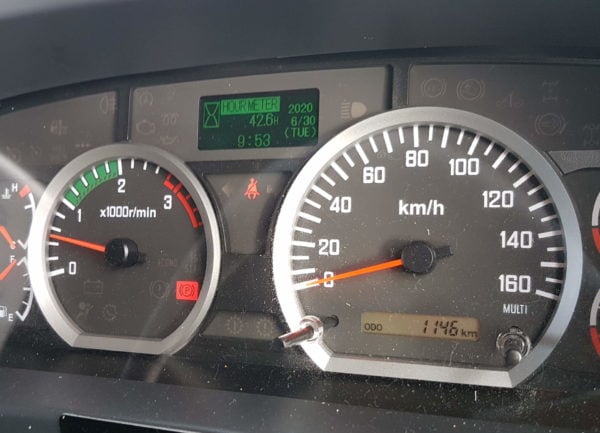Fuel costs are a significant expense in some industries. Every time an engine is idling unnecessarily (i.e. the engine is running but the vehicle isn’t moving or using it to power auxiliary equipment), fuel is being used for no purpose, leading to environmental and financial consequences.
Fuel use is a large cost for businesses. Here’s why you need an idling policy and how you can write it
The impacts of idling are greater with heavy vehicles, but don’t underestimate the impact of idling a car
What are the facts around excess fuel use?
Depending on the vehicle type and the engine size, idling can cause significant wear and tear on an engine. Ford Power Stroke Diesel literature states that an hour of idling can cause the same amount of engine wear as travelling 40km!
This idle time often isn’t measured in terms of service intervals. If a vehicle idles for just one hour a day, five days a week (which is quite a low figure for some trucks), that adds around 200km of unnecessary engine wear every week, or 10000km per year.
A truck will use between 1-4 litres per hour when idling, depending on the engine size, its temperature and how well it’s running. A car will use between 0.5 and 2 litres per hour. Your big V8 is up around 2 litres and a small 1.3-litre hatchback will be around 0.5 litres per hour. Of course, if you have a hybrid that can switch off and run for a while on a battery, idling isn’t so much of a problem.
Car idling figures
Wear and tear on a car’s engine will be less than on a heavy vehicle engine, but it is still significant. Common idling periods include waiting at meeting locations in hot weather, i.e. if early (to maintain the air conditioning temperature), eating in the car and doing paperwork between meetings or taking/making phone calls while on the side of the road.

It’s straightforward to mitigate this in all but the hottest weather by opening windows while waiting. Being early to a meeting is usually not a problem – go in and wait in the air-conditioned lobby. Eat lunch in a cafe or on a park bench.
Many light vehicles can have up to 25% of their working time idling, so there is significant opportunity for improvement.
Truck idling figures: how it affects your profit
Many heavy vehicle can have up to 40% of their operational time idling (some of this will be using PTO, though).

Assuming a small 6-tonne rigid truck, we get the following figures. Double them for a semitrailer or large rigid truck.
| Idle time per week (hours) | Km of wear/week | Km of wear/year | Fuel use/yr (at 2 litres/hr) |
| 5 | 200 | 10400 | 520 litres |
| 10 | 400 | 20800 | 1040 litres |
| 15 | 600 | 31200 | 1560 litres |
| 20 | 800 | 41600 | 2080 litres |
| 25 | 1000 | 52000 | 2600 litres |
If you have 10 small trucks idling unnecessarily for 20 hours a week, you’re using almost 21,000 litres of fuel a year which is wasted. If you have 10 tractor units idling, that’s more than 40,000 litres wasted a year, not including the additional mechanical and servicing costs. If you have to service your vehicle every 20,000km, you’ll need one extra service a year if you’re idling 10 hours a week.
Idling fatigues the oil which then accelerates wear on engine components. Spark plugs, cylinders and the exhaust system all experience wear when idling. The engine is not operating at peak temperature when idling, which can cause fuel residue buildup on the cylinder walls, fouling the spark plugs and making the exhaust system less effective.
Some drivers need to keep the engine idling when stopped in order to keep the cab warm if they are resting as part of their fatigue management.
New trucks monitor idle time. You’ll be affecting your resale value if the idle time is excessive.
You should turn your engine off, or leave it idling?
If you are going to be parked any more than 30 seconds, turn the engine off. Any more than 10 seconds idling will burn more fuel than turning the engine off and starting it again in a modern fuel-injected vehicle. Many new cars have automatic stop/start on their engines and they are good for several hundred thousand stop/start cycles.
Should you idle to warm your engine up?
In a modern vehicle, any more than 30 seconds’ idling is a waste when warming your engine up. Driving is actually the most efficient way of warming up the engine.
Pollution effects of idling
Noise pollution: Idling vehicles annoy people – the constant rumble disturbs the peace.
Air pollution: burning a litre of diesel creates 2.68kg of carbon dioxide (see our fuel calculator), while burning a litre of petrol creates around 2.31kg. Plus, other noxious gases are released, as well as particulates that can cause respiratory illness.
Is idling ever OK?
There are genuine reasons for idling
- The initial 10-30 seconds of warming up your engine
- Bringing air pressure up for braking systems in heavy vehicles
- Waiting in stationary traffic
- Idling as part of a vehicle pre-start inspection
- Cooling down a turbocharger after hard driving (e.g. lots of hills and a heavy load)
- Recharging a battery
- Servicing the vehicle or testing emissions
- Using PTO (power take-off) to operate auxiliary equipment such as a truck loader crane
- While demisting or defrosting windows (alongside taking proactive approaches such as wiping the windows and using anti-freeze)
- Maintaining the temperature of goods or animals being shipped in the vehicle
- Operating in-cab equipment necessary as part of the driver’s job or health and wellbeing (e.g. air conditioning or heater while sleeping) – however, there are alternatives to this
- Trapped in icy/snowy conditions
- Being directed by a police officer.
How should you write your company’s idling policy?
The main items to include are:
- Guidelines around how much idling time is acceptable
- Guidelines for purchasing, renting or leasing vehicles with idle-reduction features – for example, automatic stop/start, hybrid fuel system, etc
- Scenarios where idling is permitted, and any other exceptions to the rule
- Scenarios where idling is dangerous (e.g. inside a warehouse) and areas where idling must never happen
Implementing your idling policy
It’s important to track your results so that you can share the successes with your team. Taking a punitive and direct approach is never usually as good as gentle encouragement, education and (if possible) financial motivation.
You can ask the manufacturers of your vehicles to supply fuel economy data so that you can benchmark your use against their expected use, but bear in mind that if you live in a hilly area, carry heavy loads, or drive a lot in rush hour, your fuel use will be higher than expected.
Find out from your drivers when they think they are idling the most and see if any changes to scheduling, routes or other processes can help reduce it.
Explain the environmental and economic issues caused by idling. Use examples of the effects on people (lung disease, asthma, the unpleasant effect of breathing in fumes through your open windows at home – this is a particular problem at some apartment buildings).
Agree some targets for reducing fuel use, e.g. 5% within 6 months. Any drivers that fall behind in the benchmarking and fail to make any improvements perhaps would benefit from SAFED training or in-cab assessments. You could consider other driver training alongside this to improve fuel economy in general.
Decide on whether you want to share any savings with your team in the form of cash incentives, improvements to your facilities, additional training, vehicle upgrades, etc.

